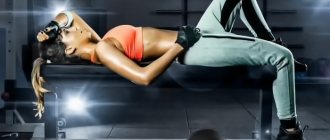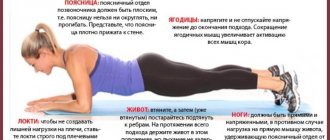Why do we feel pain after training?
There can be several reasons for pain after exercise. X- group programs in Russia spoke about the causes and symptoms :
- Pain, more precisely, burning in the muscles, occurs during the exercise, towards the end of the approach. The reason is the accumulation of metabolic products in the muscles, primarily lactic acid salts. This is a normal phenomenon, since chemical reactions are constantly taking place in muscle cells, during which energy is released, due to which they work. As a rule, such pain goes away within a maximum of an hour after training.
- Delayed pain appears the day after training or even every other day. This symptom is caused by microtraumas in the muscles that can occur during intense exercise.
- Another cause of pain is injuries to the musculoskeletal system: dislocations, sprains, etc. As a rule, they occur suddenly, during or immediately after an incorrect movement, and do not allow you to continue training. With these symptoms, of course, you should immediately consult a doctor.
Prospects for treatment
It is important to understand what exactly is the cause of the condition that has arisen. During the examination, the doctor may prescribe a CT scan and also perform arthroscopy. First of all, you need to make sure that these are not acute inflammations or diseases related to the activity of the spinal cord or brain.
As soon as it is possible to discover the reasons why the arm does not extend, the doctor will tell you what to do to eliminate the pain syndrome and further treatment. Possible methods:
- drug treatment;
- manual therapy;
- massages.
In exceptional cases, surgery may be required. However, most often it is enough to adjust the patient’s lifestyle, massage and take prescribed medications. There are many reasons for damage to the elbow joint and pinched nerves: from injuries and the developing inflammatory process to the consequences of sleeping in the wrong position. And only a doctor can determine them accurately.
Why don't my arms straighten after training?
Beginning athletes need to listen to their body especially carefully. Pain can tell you how correctly you have drawn up your training program and selected weights. Let's look at the main symptoms.
After training, the elbows and hands do not straighten
This indicates that you have overloaded the shoulder flexor - the biceps. “Most often this occurs after an isolated arm workout,” says Yulia Malenchuk, “or after a back workout, when it was not possible to control the technique (for example, you took too much weight) and the biceps took part of the load from the back.”
In any case, severe pain after training is not normal and indicates overtraining. It is necessary to adjust the load downward, and perhaps choose other exercises.
Muscle microtraumas
In principle, microtraumas are normal and even necessary.
“In muscle, like in any other tissue, processes of synthesis (anabolism) and breakdown (catabolism) are constantly ongoing,” explains Yulia Malenchuk. During training under load, the processes of catabolism begin to prevail over synthesis, but during the recovery process, synthesis is more active. This increased anabolism is used by athletes for muscle hypertrophy (muscle building). When any injury occurs, the body begins to heal itself. When the bend of your arm or another trained area hurts after training, this is muscle recovery. It is at this time that new muscle tissue grows, which athletes need. Severe pain indicates that you have overdone the load and there are too many microtraumas.”
Hands are swollen
In the area of microtrauma, blood flow increases and the number of leukocytes increases. As a result, swelling occurs, which, in fact, causes pain due to the fact that it puts pressure on the nerve endings. “In such cases, the muscle may look swollen and inflated,” warns Yulia Malenchuk. If the swelling is not distributed throughout the muscle, but is localized, especially in the joint area, see a traumatologist
Mild dislocation
A similar incident happens when people - out of ignorance or out of conceit - do an exercise with the wrong technique. For example, when bench pressing a barbell, first one arm is straightened, then the other (yes, this happens!). Overload of the joint can result in dislocation or injury to the ligament. Acute pain during or immediately after exercise, or changes in joint mobility are a problem that should promptly consult a doctor. The dislocation will not go back into place on its own; it needs to be straightened or at least properly fixed.
Trembling hands after exercise
Tremor - involuntary muscle contractions - is a rather unpleasant disease associated with fatigue of the nervous system. “During training, not only muscles work, but also the nervous system that controls these muscles,” explains Yulia Malenchuk. “The brain constantly sends nerve impulses that are transmitted along motor neurons to the muscles.” Involuntary muscle contractions as a result of fatigue of the nervous system can be associated with the depletion of neurotransmitters (substances that deliver impulses to the muscle cell) or with a lack of mineral elements that are involved in the conduction of nerve impulses (calcium, sodium, magnesium, etc.).
Numb hands
Another symptom of nervous system fatigue during exercise. “If it persists even the next day, this may indicate a pinched nerve or other neurological problems,” warns Yulia Malenchuk, “visit a therapist or traumatologist.”
Pathological causes
You should consult a doctor as soon as possible if elbow pain is accompanied by other negative symptoms. These are hematomas, swelling, limitation of movements, decreased sensitivity and/or redness of the skin, increased local or general temperature, visible deformation of the joint, and constant swelling in the morning. Any of these signs indicates:
- getting injured;
- development of inflammatory or degenerative pathology.
The sooner the doctor conducts an examination and begins treatment, the lower the risk of developing severe irreversible complications. In case of injury, therapy is usually conservative - wearing orthopedic devices that limit the load on the joint, gradual development of all structures of the elbow. Treatment of pathologies takes longer, and its success depends on the type of disease and stage of the disease.
Injuries
It is impossible not to notice an intra-articular fracture or fracture of the shoulder bone, as is a dislocation. The resulting pain is so acute that the person loses consciousness. Fractures most often occur during active sports - football, handball, athletics. Sharp pain is also a symptom of complete or partial rupture of muscles, ligaments or tendons, commonly called a sprain. To restore the integrity of these structures, both conservative treatment methods and surgical intervention can be used.
Fracture on x-ray.
No less dangerous is microtrauma of soft, cartilage, bone tissue, muscles, ligaments, and tendons. And these injuries are typical for professional athletes. As a result of intense physical activity, the integrity of individual fibers is compromised. In the future, there are more such damaged structures, which affects the functioning of the muscle or ligament.
If left untreated, including reducing the duration and intensity of training, microtraumas can cause the development of severe recurrent pathologies.
Pathologies
You should not independently identify any articular pathology; take into account only the nature of the discomfort in your elbow. Pain of varying variability occurs with arthrosis, gout, arthritis, and tendovaginitis. In acute pathologies it is cutting, stabbing, piercing, and in chronic pathologies it is aching, pressing. Only a doctor can make the correct diagnosis after conducting a series of instrumental and bacteriological studies.
There are pathologies that most often affect the elbow joints of professional athletes due to constant microtrauma of tissue:
- epicondylitis - lateral or medial. Degenerative-inflammatory disease of the elbow joint, developing at the attachment points of the tendons of the inner and outer surface of the forearm;
- tendinitis. Acute or chronic inflammatory disease in the tendon area. In the absence of treatment, it provokes the appearance of often irreversible destructive-dystrophic changes;
- Tenosynovitis. Inflammation of the tendon and its surrounding membrane. The main difference from tendinitis is the development of pathology in the area of tendons with sheaths, or soft tunnels, consisting of connective tissue.
- bursitis. Acute, subacute or chronic inflammation of the synovial bursa, accompanied by the formation and accumulation of exudate in its cavity. Acute pathology develops due to injury, chronic pathology develops due to constant mechanical irritation.
All these diseases, unlike arthrosis or arthritis, are highly treatable, and the prognosis for complete recovery is favorable.
Arthrosis can be the result of a serious sports injury or regular microtrauma. But the cause of the development of arthritis is often a dysfunction of the immune system, genetic predisposition, infection, or a significant decrease in immunity.
| Physical exercises that lead to pain in the elbow joint | The most likely causes of discomfort and accompanying symptoms |
| Flexion and extension | Arthrosis deformans, subacute or chronic bursitis, any form of arthritis. The main signs are pain that intensifies after training, swelling of the joint, redness of the skin in the elbow area. With lateral epicondylitis, discomfort appears when clenching your fists |
| Lifting weights | Subacute epicondylitis. A person is not able to hold heavy objects with outstretched arms for a long time. Painful sensations occur only during training and are absent at rest |
| Active sports (tennis, volleyball, basketball, skiing) | Microtrauma of muscles, ligaments, tendons, subluxation, lateral or medial epicondylitis, cubital tunnel syndrome. In addition to pain, the clinical picture includes swelling and stiffness of movement. |
| Pull-up on the horizontal bar | Epicondylitis, bursitis, arthritis, thoracic or cervical osteochondrosis, ulnar nerve neuritis. The pain that occurs after training is so severe that the athlete cannot start exercising within 24 hours |
How to exercise to avoid muscle pain?
To prevent painful sensations from causing discomfort, a well-chosen load and control of the exercise technique, as well as compliance with the drinking regime, are necessary.
Warm-up and cool-down
A proper warm-up will warm up the muscles, make them more elastic, and thereby prevent excess microtrauma and, especially, injury. Spend 5-10 minutes doing low-intensity exercise and moving your limbs and body in different directions. For example, light running (can be done on the spot), walking with knee lifts and heel overlapping, arm lifts in different directions, body tilts, pelvic rotations.
First technique - then weights
First, practice the correct exercise technique with little or no weights, and only then take on serious weight. If you don’t understand how to do an exercise correctly (this often applies to new, unfamiliar exercise equipment), look for someone who will show you, or replace it with a familiar movement.
Drinking regime
We lose minerals and water through sweat during exercise. Their lack leads to a deterioration in the conduction of nerve impulses. The consequences are increased fatigue, overtraining and even injury. Drink still water or special sports drinks as soon as you experience a feeling of dry mouth.
How to get rid of pain in elbow joints
1. It is necessary to numb the pain.
To do this, use various cooling ointments (they include analgesics, essential oils and menthol), injections (novocaine or lidocaine), and analgesic gels. It is also possible to use various syrups and tablets to relieve pain. Take all painkillers in the presence of a doctor.
2. Relieve inflammation.
To relieve swelling, redness and improve microcirculation, it is best to take products containing non-steroidal anti-inflammatory components. These include: diclofenac, ketoprofen, indomethacin.
When the worst is over and you are in the process of rehabilitation, then you need to use ointments with a warming effect. Such gels and ointments should contain pepper and mustard extract. They should be applied in a circular motion. Also take the anti-inflammatory medications described above.
In order to avoid pain in your elbows after training, you still need to take care of your joints and carry out preventive measures to prevent the destruction of cartilage.
How to reduce pain?
Perhaps our article is late, and your muscles are already burning, and your arms cannot be straightened. If you are sure that it is due to overuse and there is no injury, you can try the following ways to reduce pain.
Water treatments
A contrast shower, warm bath, hydromassage or swimming pool effectively relieves swelling of the muscles and improves their mobility. However, you should not overheat, because hot water or a sauna will increase inflammation, the synthesis of leukocytes and, as a result, swelling will increase. You can use an infrared sauna, which does not heat much and has an anti-inflammatory effect.
Proper nutrition
A sufficient amount of protein (meat, dairy products, fish) and an abundance of antioxidants (vegetables, fruits) will speed up recovery. You should eat 0.8 - 1.5 g of protein per 1 kg of your weight every day. Vegetables contain the trace element potassium, which reduces swelling by removing excess water from the intercellular space.
Relaxing massage
You can use both manual and hardware relaxing or lymphatic drainage massage. Do not do corrective or anti-cellulite massage if your muscles hurt! During these procedures, the subcutaneous fat tissue is slightly undermined from the muscles, this will only increase the pain.
Pain relief with medications
You can use sports ointments with anti-inflammatory and cooling effects. Do not warm up under any circumstances - the same principle as with water procedures. If the ointment does not help, this is a sign of serious damage. See your doctor for a diagnosis and appropriate treatment with prescription pills or injections.
SYMPTOMS AND MANIFESTATIONS
At first, tendonitis may resemble other joint diseases. When moving the body and limbs, a person feels a dull pain. There may be no pain when stationary. The risk is that the patient copes with the pain and does not stop moving, injuring the ligaments even more. They can be damaged more.
Developing inflammation shows more pronounced symptoms. Aching pain does not go away with rest and intensifies during palpation. The joint moves worse, a crunching sound is heard. Swelling, redness, and hot skin are visible.
If left untreated for a long time, degenerative manifestations begin. Fibrosis forms; upon palpation, the doctor detects osteophytes and calcifications.











